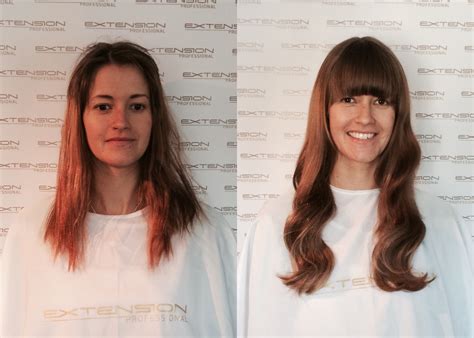Introduction
Hair extensions have become an indispensable tool for hair stylists and individuals seeking to elevate their appearance. From adding length and volume to concealing thinning areas or experimenting with different hair colors, hair extensions offer versatile solutions for a myriad of hair concerns. This comprehensive guide delves into the world of professional hair extensions, providing essential information on application techniques, types, maintenance, and the latest advancements.

Types of Professional Hair Extensions
Professional hair extensions encompass a diverse range of methods and materials, each tailored to specific hair needs and aesthetic preferences. Some popular types include:
- Clip-In Extensions: Offer instant, non-permanent transformation with clips that attach to natural hair.
- Tape-In Extensions: Seamlessly blend with natural hair using hypoallergenic tape adhesive.
- Keratin Bond Extensions: Utilize heat-activated keratin bonds to create long-lasting, durable extensions.
- I-Tip Extensions: Utilize microscopic beads to attach individual strands of hair to natural hair.
- Fusion Extensions: Employ heat and ultrasound to fuse individual strands of hair to natural hair.
Application Techniques
The application technique for professional hair extensions varies depending on the type chosen. Each method requires specialized training and expertise to ensure proper installation and seamless results.
- Clip-In Extensions: Clip along the base of natural hair, starting at the back and working forward.
- Tape-In Extensions: Apply adhesive tape to sections of natural hair and press the extension into place.
- Keratin Bond Extensions: Apply heat to keratin glue and attach the extension to a strand of natural hair.
- I-Tip Extensions: Thread a bead onto the extension and a strand of natural hair, then clamp down to secure.
- Fusion Extensions: Use heat and ultrasound to fuse the extension to a strand of natural hair.
Maintenance and Care
Proper maintenance is crucial for the longevity and quality of professional hair extensions. Follow these guidelines:
- Regular Brushing: Brush hair daily to prevent tangles and matting.
- Gentle Washing: Wash hair with sulfate-free shampoo and use a wide-toothed comb.
- Conditioning: Apply conditioner to the extensions to keep them soft and hydrated.
- Protection from Heat: Use heat protectant spray before using styling tools.
- Professional Removal: Have extensions professionally removed to avoid damage to natural hair.
Latest Advancements in Hair Extensions
The hair extension industry is constantly evolving, with new advancements emerging to enhance the quality and application of extensions. These include:
- Invisible Extensions: Use transparent adhesive tapes or bonds to create seamless, undetectable extensions.
- Pre-Bonded Extensions: Come with pre-applied bonds for faster and more efficient installation.
- Double-drawn Extensions: Feature thicker, fuller hair strands that create natural-looking volume.
- Synthetic Extensions: Offer a more affordable alternative to human hair extensions, with improved durability and heat resistance.
Benefits of Professional Hair Extensions
Professional hair extensions provide numerous benefits:
- Transformation and Enhancement: Create desired length, volume, color, or texture.
- Confidence Booster: Improve self-esteem and confidence with a more voluminous and youthful appearance.
- Time-Saving Solution: Offer an immediate and long-lasting solution for busy individuals.
- Non-Permanent: Clip-in extensions allow for easy removal and flexibility in styling.
Drawbacks of Professional Hair Extensions
While professional hair extensions offer significant benefits, there are also some potential drawbacks:
- Cost: Professional hair extensions can be expensive, depending on the type and quantity required.
- Maintenance: Extensions require regular care and maintenance to ensure their longevity.
- Damage to Natural Hair: Improper application or removal can potentially damage natural hair.
- Risk of Allergic Reactions: Some adhesives used in extensions can cause allergic reactions.
Tips and Tricks
Follow these tips for optimal results with professional hair extensions:
- Consult a Professional: Always seek consultation from a reputable hair stylist before applying extensions.
- Choose the Right Type: Select the type of extension that best suits your hair needs and lifestyle.
- Quality Matters: Invest in high-quality extensions to ensure durability and longevity.
- Home Care: Follow maintenance guidelines for proper extension care.
- Avoid Overstyling: Overusing styling tools can damage extensions.
Compare Pros and Cons
| Feature | Clip-In | Tape-In | Keratin Bond | I-Tip | Fusion |
|---|---|---|---|---|---|
| Installation Time | Quick | Moderate | Long | Moderate | Long |
| Longevity | Temporary (reusable) | Semi-permanent | Semi-permanent | Semi-permanent | Long-term |
| Damage to Natural Hair | Minimal | Minimal | Moderate | Minimal | Moderate |
| Cost | Low | Moderate | High | Moderate | High |
| Maintenance | Moderate | Moderate | High | Moderate | High |
Conclusion
Professional hair extensions offer a transformative solution for individuals seeking to enhance their hair’s length, volume, color, or texture. With proper application, maintenance, and care, professional hair extensions can provide long-lasting results and a boost in confidence. However, it is important to weigh the benefits and drawbacks carefully and consult a professional hair stylist for personalized advice and guidance.
